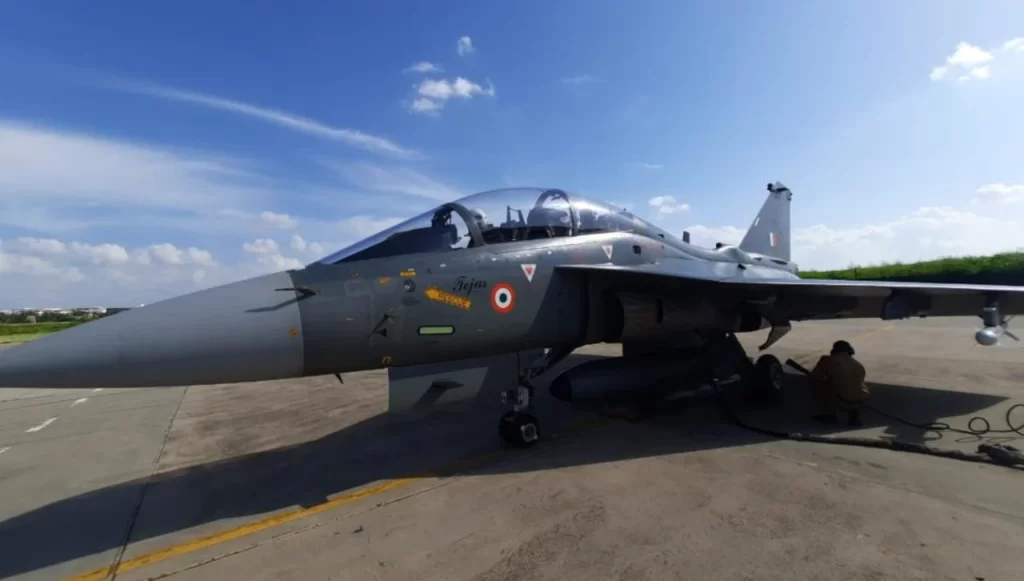On September 8, the Deputy Chief of the Air Staff (DCAS), Air Marshal Ashutosh Dixit, AVSM, VM, VSM, visited Hindustan Aeronautics Limited (HAL). He was there to inspect the production facilities for the LCA Mk I Twin Seater and the Mk IA.
Photographs of him engaging with Tejas Aircraft Division Officers and floor-level technicians were published by HAL. These photographs were taken on the assembly floor when the LCA MkI Twin Seat or the Light Combat Aircraft Trainer (LCA) was being built.
On April 5, 2023, Hindustan Aeronautics (HAL) successfully took off from its airport to launch the first series production standard Light Combat Aircraft (LCA) Trainer (LT 5201). As seasoned HAL test pilots, Gp Capt Venu (Retired) and Wg Cdr (Retired) Awasthi piloted the first flight of the LT 5201. A crucial milestone was reached for the LCA Tejas Programme when the trainer aircraft completed the mission that lasted 35 minutes. The successful flight was due to the efforts of the large group of engineers, designers, and technicians from HAL’s LCA team, along with support from the Aeronautical Development Agency (ADA), the Centre for Military Airworthiness and Certification (CEMILAC) and the Directorate General of Aeronautical Quality Assurance (DGAQA).
As part of an LCA Tejas induction plan, the Indian Air Force (IAF) has ordered around ten twin-seater LCA trainers. This order is in preparation for commissioning 83 Tejas Mk-1As, an enhanced variant of the Tejas Mark 1. This process is scheduled to commence in 2019. IAF inked a deal to procure LCA Tejas Mk 1As in February of 2021, and this provision was a part of that agreement. There will be 73 aircraft with single seats and 10 with dual seats, which is shorthand for training aircraft.
This is the DCAS’s second known visit to the facility. He visited the National Flight Test Centre, ADA, and HAL Tejas Division on June 15 to assess the progress of indigenous combat aircraft programmes. As an enthusiastic Experimental Test Pilot, he is directing the IAF’s endeavours to develop and manufacture its own combat aircraft. During his visit, the Air Marshal flew the Series Production LCA Trainer-01, undertaking final developmental test flights to experience its capabilities firsthand. The IAF is presently operating the LCA Mk 1 aircraft.
LCA Tejas Trainer Mk1 A
The LCA Tejas Trainer is a two-seater variant of the LCA Tejas, which was designed and built in India by the ADA and HAL. The primary purpose of this trainer is to train pilots for combat operations and other types of missions. In addition to training potential LCA Tejas pilots, this aircraft will give Indian pilots the experience necessary to fly modern fighter aircraft, which is required for those piloting different types of Indian fighter aircraft.
The Tejas Trainer is a state-of-the-art aircraft that integrates technology and design aspects that are on the leading edge of their respective fields. The fly-by-wire flight control system of the aircraft permits precise movement control, while the digital flight control system enables autonomous flight control and navigation. The powerful avionics system of the aircraft, which includes a glass cockpit and cutting-edge radar, gives the pilot an unimpeded view of the area around them and essential flying data. One of the traits that sets the Tejas Trainer apart from other aircraft is its ability to perform complex manoeuvres, such as high-G spins and rolls.

In addition, the General Electric F404-GE-IN20 turbofan engine installed in the Tejas Trainer can produce 84 kN of thrust on its own. The dimensions are 13.2 metres in length, 8.2 metres in width, and 4.4 metres in height. The engine is controlled by a Full Authority Digital Engine Control (FADEC) system, which ensures that the functioning is dependable and effective. In an emergency, the pilot and co-pilot of the aircraft are provided with a safe means of evasion in the form of ejection seats manufactured by Martin-Baker and designated as MK16. The Tejas Trainer has a maximum takeoff weight of 13,500 kilogrammes and a maximum speed of Mach 1.8. Both of these figures are in kilogrammes. The maximum service ceiling is 50,000 feet, with a range of 1,200 kilometres. The aircraft can transport a wide variety of armaments, including air-to-air missiles, air-to-ground missiles, and bombs. A head-up display (HUD) is installed in the aircraft’s cockpit. This display places important flying information on a see-through screen and is positioned directly in front of the pilot.
With a price tag of roughly 280 crores of rupees per unit, the LCA Tejas Trainer is the aircraft of the four-and-a-half generation that is the least expensive option currently available.
The LCA Tejas Trainer is also an essential component of India’s decades-old “Make in India” effort, which aims to raise the country’s domestic production level while decreasing its reliance on suppliers located in other countries. More than 55% of locally sourced materials are used in manufacturing the LCA Tejas Trainer standard. The Indian Air Force has shown full faith in the LCA Tejas Trainer.
